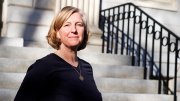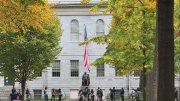In a public announcement that Harvard College would increase financial aid to match peers’ augmented offerings, and a private conversation reviewing the status of the Faculty of Arts and Sciences (FAS) as it confronts more straitened finances, Dean Hopi Hoestra has established priorities for an increasingly uncertain but more austere future.
Financial Aid: Catching Up with the Competition
Undergraduate financial aid is being expanded and redefined in three ways, according to the announcement by President Alan M. Garber and Hoekstra this morning:
•Students whose family income is $100,000 and below will attend Harvard College free of charge—an increase from the prior income threshold of $85,000.
•Students whose family income is $200,000 and below will be granted “free tuition plus”: their financial aid will cover the full cost of tuition ($56,550 of the 2024-2025 term bill) and they will be evaluated individually for further aid to cover other billed expenses such as room, board, and fees (respectively, $12,922; $8,268; and $5,126).
•For students whose family income exceeds $200,000, “tailored financial aid” will be extended depending on Harvard’s evaluation of individual circumstances.
These enhancements apply to the entire enrolled College cohort, not just members of the class of 2029 who matriculate in August. According to the announcement, 55 percent of undergraduates receive financial aid; they and their families paid an average of $15,700 during the 2023-2024 academic year, when the term bill was $79,450.
The changes in competitive context… Since Princeton eliminated loans from its aid program in early 2001, and the Harvard Financial Aid Initiative (HFAI) debuted in 2004 (making the cost of attendance zero for students whose family income was $40,000 or less), peer institutions have engaged in heightened competition to make their need-blind aid packages both more generous—covering more families—and easier to understand. The College upped the income threshold to $60,000 in 2006 (and eliminated loans in 2007), and then again to $85,000 in 2023.
In recent years, other institutions have seized the financial-aid initiative from Harvard, in two ways.
First, of course, is the money: As reported in March 2024, when the College announced admissions data on the class of 2028, both Princeton (which is fully endowed for financial aid, unlike the FAS) and Stanford had raised their income threshold for free attendance to $100,000 for the class of 2027. Upping the ante, on March 25, 2024, Dartmouth announced that a $150-million bequest would enable it to nearly double its free-attendance threshold from $65,000 of family income to $125,000—the highest in the country—effective with that fall. More limited programs at Duke and the University of Virginia made attendance tuition-free for students from local families with incomes under $150,000 (North and South Carolina) or $100,000 (Virginia), respectively, presenting still more competition. And most recently, MIT announced last November that beginning this autumn, undergraduates from families with incomes below $100,000 would attend free of charge (an increase from a $75,000 threshold), and those with family incomes below $200,000 would attend tuition-free (up from $140,000). The University of Pennsylvania will match the MIT tuition-free threshold (while retaining a $75,000 family income standard for zero-cost attendance).
Second, to overcome families’ sticker shock at posted $80,000-plus term bills (a strong deterrent to applying), the way in which aid is described is shifting. A major HFAI emphasis was demystifying aid, so applicants from lower-income families could readily determine their prospective college costs—or be assured that they would incur none. As described by the Harvard Financial Aid Office’s “How Aid Works” webpage (at least before today’s announcement), above the $85,000 family income threshold for free attendance during 2024-2025, “Families with annual incomes between $85,000 and $150,000 will contribute between 0 and 10 percent of their income. Those with incomes above $150,000 will be asked to pay proportionately more than 10 percent based on their circumstances.”
According to the March 2024 University news release on class of 2028 admissions, “Nearly one-quarter of students attend Harvard with no parent contribution”—meaning their family incomes then were $85,000 or below. That suggests that across the other 30 percent of the undergraduates receiving aid, the average family cost would have been somewhat less than twice the $15,700: from a minimal amount (a percent or so of family income for those with income in excess of $85,000) to more than the average (more than 10 percent of family income for those with income in excess of $150,000), per the stepped percentage-of-income formula.
As a practical matter, for most students, the level of aid granted under the new tiers unveiled today may not differ that significantly from the prior level of aid (including that granted under the stepped-up contribution for those with family incomes above $150,000). This year’s term bill is $82,866 (including the $56,550 tuition component); assuming the 2025-2026 bill again increases about 4 percent, to about $86,000 (and tuition to about $58,800), families with incomes of $200,000 or less will be looking at an additional aid amount (“free tuition plus”) to cover some portion of $27,200 of room, board, and fees. Under the old formula, those with incomes of $150,000 and above were going to be asked to pay somewhat in excess of 10 percent of family income toward their child’s annual cost of attendance, depending on their individual circumstances. The aim of the new aid structure is to provide some benefit for families in the middle-income band.
Updated March 25, 2025, 9:20 a.m.: The College has posted, but not otherwise announced, the 2025-2026 term bill: $86,926, a larger-than-estimated increase of $4,060, or 4.9 percent, over the current year. That represents a continuing, sharp escalation in the rate of increase from prior years: the 2024-2025 term bill was 4.3 percent larger than the prior year’s, which in turn represented a 3.5 percent increase over year before that (and a preceding long period of 3.0 percent annual increases).
The billed expenses include tuition ($59,320), room ($13,532), board ($8,598), and fees ($5,476). Under the new financial aid terms, students from families with incomes of $200,000 or less will not be billed for the tuition part of the annual charges, and those with incomes of $100,000 or less will attend free of charge.
But as a communicative matter, it may be a simpler sell, or a more comforting one, simply to tell applicants’ families that the tuition part of the cost of attendance is zero for those households with incomes $200,000 and below, and that some aid may be in the offing for the rest of the term bill.
In other words, by today’s announcement, Harvard College is meeting much of the market in both the level of aid it offers, and the description and structuring of that scholarship support.
…and in FAS’s changing fiscal context. The timing of the augmented financial aid announcement is strategic: applicants to the Harvard class of 2029 are about to learn whether they have been admitted—and will want to compare scholarship offers as they choose where to matriculate.
But the timing is also difficult for Harvard and FAS, which have made announcements in the past two weeks about the need for belt-tightening amid President Donald Trump’s threats to research funding and other financial pressures (see below and “Harvard Announces Hiring Freeze,” which also reports on prospective reductions in Graduate School of Arts and Sciences admissions). Last year, when it became imperative to increase graduate student stipends at an aggregate cost of many millions of dollars (Harvard had fallen well behind peers’ offers, the local cost of living is extremely high, and Graduate School of Arts and Sciences admissions yields had accordingly plummeted), FAS seemed well positioned to bear the expense.
The faculty’s fiscal position is clearly less comfortable now—and the level of budgetary uncertainty is increasing. But the expense of the undergraduate aid enhancements (no figure has been disclosed) may be less than meets the eye, for two reasons.
First, as noted above, to the degree that for the middle-income cohort shifting from the current model (graduated costs from 0 to 10 percent of family income for those in the $85,000-$150,000 income band) to the new, enhanced one (free tuition plus under $200,000) is a matter of definition or description, FAS’s incremental investment in aid may be relatively modest.
Second, a lingering effect from the pandemic may further cushion the impact on FAS’s finances. Student leaves of absence and deferrals of admission during the period of remote instruction continue to work through Harvard’s undergraduate enrollment. According to FAS’s financial annual report for the fiscal year ended June 30, 2024, “From a peak average enrollment in residence in fiscal 2023 of 7,058, fiscal 2024 enrollment declined to 6,960. The class of 2025 represents the last of these large cohorts, and we expect to return to more typical enrollment of approximately 6,650 by fiscal year 2026”—i.e., the period when the new aid plan comes into effect, beginning this August. That might mean that although the proportion of students eligible for the more generous scholarship program grows in the next academic year, the enrolled student body overall will be smaller, possibly offsetting in part or whole the absolute number of those receiving aid.
A statement of priorities. However those practicalities work out, reworking College financial aid now is a statement of institutional commitment. As President Garber said in the announcement, “Putting Harvard within financial reach for more individuals widens the array of backgrounds, experiences, and perspectives that all of our students encounter, fostering their intellectual and personal growth. By bringing people of outstanding promise together to learn with and from one another, we truly realize the tremendous potential of the University.”
It is also a statement about priorities, highlighting student access to Harvard, as FAS embarks on what may be a protracted, and uncomfortable, reexamination of its resources.
Read the University announcement here.
Anchoring FAS in Testing Times
As Hoekstra told faculty colleagues during the March 4 FAS meeting, this is “a time of uncomfortable uncertainty” amid executive orders affecting higher education, challenges to same in the courts, sweeping new guidance on diversity from the U.S. Department of Education, and more. “We need to prepare for significant financial challenges,” she continued, building “financial capacity” by finding ways to reduce expenses and enhance revenues. FAS, she said, is already in a “structural deficit.”
They had already received sobering budgetary guidance (flat spending, no incremental staff hiring, per the Crimson), reflecting both the new order in Washington and the Harvard Corporation’s decision to reduce the rate of growth in endowment distributions—FAS’s largest source of revenue—for the next fiscal year. Then, on March 10, President Garber announced that Harvard will “implement a temporary pause on staff and faculty hiring”—and the next day Hoekstra undoubtedly got professors’ attention by deciding that all graduate students on the waitlist for admission next fall would be denied admission. In most years, GSAS enrolls a majority of the candidates it admits. But for many programs, especially ones welcoming small cohorts, a misestimated yield might result in fewer matriculants than wanted. If waitlisted applicants are, across the board, excluded from admission, GSAS might well end up enrolling smaller graduate cohorts next fall (with cascading future effects on the availability of teaching fellows for undergraduate courses). This is not an outright cut in graduate admissions ordered from University Hall (Brown, Penn, the University of Massachusetts Medical School, and Harvard’s School of Public Health have all reportedly made such cuts)—but Hoeskstra’s directive points to the heart of FAS’s academic mission.
These rapid-fire announcements put Hoekstra’s job in a familiar perspective. In just the past quarter-century, the FAS dean has had to manage abrupt transitions in Massachusetts Hall (where her or his boss, the president, works), in 2006 and 2024; financial crises (in 2008-2010, and as COVID-19 spread in early 2020); and then the shuttering of residential education for most of three semesters during the pandemic. Hoekstra’s whipsaw experience may have set a new University Hall record: she took office August 1, 2023—all of nine weeks before the Hamas attack on Israel tore the campus community apart; Claudine Gay stepped down as president the following January 2; and now, 18 months into her tenure, Dean Hoekstra faces a potentially major financial upheaval.
During a conversation on March 13, she displayed preternatural calm about all that, and about the unexpected agenda FAS had followed since the fall of 2023. Recalling her decision to uproot herself from the West Coast and to join the faculty in 2007, she said, “I just love Harvard and the FAS in particular. I believe in its mission.” As a scientist, she said, “I felt I could do anything here,” limited only by her imagination, and indeed her time in the lab and classroom in Cambridge was “golden.” When asked to assume the deanship, accordingly, “It felt like something I wanted to take on,” to assure that other scholars could have the same opportunities for research and teaching.
In a couple of ways, she said, her deanship had resulted in unexpected opportunities “to meet the moment.”
Focusing on academics. The first of these has been a number of back-to-basics initiatives to restore the conditions for and repair the conduct of academic discourse on campus, and to examine academic focus and rigor. Hoekstra said the campus confrontations over the Middle East had made apparent “cracks in the [community’s] foundations”—widening faults that required immediate attention. In response, she pointed to the faculty’s focus in 2023 and 2024 on civil discourse (“address[ing] an issue we’ve had on campus for a while”), and, this winter, on the classroom social compact (centering academics, assuring the confidentiality of students’ discourse within their courses), and grading and evaluation.
The outcome of the faculty’s work on these priorities, she said, aligned with her own best experiences as a professor. She cited an early, vigorous scientific debate over an emerging field, with strongly argued positions from different perspectives; a resulting set of experiments; gathering of data; and, as a result of all that, “It felt like the field was reinvigorated.” That kind of engagement was her aspiration for FAS classrooms—and, more immediately, for FAS’s faculty meetings and deliberations, which have been remade on her watch. Since Hoekstra became dean, she, rather than Harvard’s president, has run the meetings. And following an ad hoc group’s assessment of the meetings, at her request, this academic year they are now more substantive (with routine matters and materials handled online); structured to accommodate in camera discussions of significant issues or to accommodate private meetings with guests (like a conversation with President Garber after the formal business on the agenda was completed at the March 4 session); and, as in her first year, often enlivened by a colleague’s “research minute” (a substantive presentation on her or his academic pursuits, albeit in five minutes). The latter presentations, she said, “remind ourselves why we’re here.”
Those changes, and the focus on matters of real concern to the faculty, have had an effect. Hoekstra glowed about the faculty’s “fantastic discussions of grade inflation and grade compression” and the classroom compact legislation, with multiple members at all professorial levels participating, articulating important and fresh insights from diverse perspectives and disciplines: “a model of civil discourse.” Within a faculty that in the view of many observers (and not a few of its members) has not always managed to energize its conversations or move forward on matters of substance, she welcomed its ability to “talk as a community.”
Hoekstra has worked hard to build that community. She noted that she has organized 10 lunches each semester, each with eight faculty colleagues, “just to talk about our scholarship.” That has built connections in what can be a large, atomized group (FAS has 730 tenured and ladder-track faculty) spread across dozens of disciplines, and has resulted in the occasional “magic moment” of teaching and research collaborations. That is “one of the bright spots” in her deanship, she said.
Focusing on finances. That social capital may count as FAS begins to meet its second unexpected moment: the looming financial challenge. On the morning of March 13, she dispatched a “dear colleague” missive outlining principles as “we continue our work to build financial capacity and resiliency”—beyond the pause in hiring and the decision to freeze graduate admissions from waitlists. She offered principles for proceeding: focusing on the core academic mission of research and teaching; dismantling administrative silos and fostering collaboration; safeguarding “academic freedom and the rights and responsibilities that are essential to our ability to fully pursue our academic mission”; and “building a community that brings together and supports a range of perspectives and opinions.”
That is, admittedly, high-minded stuff. Hoekstra is banking on the faculty’s heightened comity and focus after the past 18 searing months to address FAS’s constraints effectively. Recent history might be of some help. In retrospect the University financial crisis of 2008-2010 came and went relatively quickly, with a few years of robust endowment returns and donors’ generosity during the $9.6-billion Harvard Campaign resulting in a period of restrained growth, but not severe reorganization or internal culture change. The financial preparations for the pandemic, and FAS’s highly collaborative planning for remote instruction, augmented by excellent communications from President Lawrence S. Bacow and then-FAS Dean Gay, modeled a different, more successful way of adapting. Putting those experiences together suggests ways Hoekstra, her senior leadership team, and the faculty as a whole might join forces to effect more lasting change in FAS’s organization and cost structure.
The strategic planning Dean Gay initiated might be of some use, too. FAS knows it has a structural deficit because of the financial modeling and planning process put in place at the start of that work. (Hoekstra noted that she and her leadership group had convened with Olshan professor of economics John Y. Campbell and Safra professor of economics Jeremy C. Stein, who directed FAS’s pandemic and then long-term financial planning during 2020-2021—gaining an “incredibly important” perspective for the current circumstances.) Some of the divisional recommendations—perhaps reorganizing arts and humanities administration, standardizing how freestanding centers operate and are funded, creating an FAS-wide mechanism for accelerating investment in new disciplines—have been in limbo as Hoekstra appointed new deans and then coped with the calamities of 2023-2024. But they may well inform the divisional deans’ approach to the new financial constraints.
However FAS proceeds, Hoekstra is clear that the continuing structural deficit, and the changed “external circumstances,” mean that cracks in the financial foundations have become a pressing concern, too. The work of addressing them, she said, “has become more urgent.” FAS “can’t be a place that is all things to everybody,” she continued. The faculty faces “hard truths and hard choices,” and can only address them together.
Those choices will only get harder as it comes time to decide about looming major FAS capital projects, like Eliot House renewal; to absorb the costs resulting from Harvard’s multiple contract negotiations with the clerical and technical workers, graduate students, and academic workers unions; and to adapt to any further shocks emanating from the nation’s capital.
A look over the horizon. Unsurprisingly, in light of the circumstances she has encountered as dean so far, Hoekstra hasn’t had “as much space as is maybe typical” for someone new in her role to consider the exciting intellectual opportunities in FAS’s future. But she does point to two initiatives.
One, inevitably, focuses on generative artificial intelligence, which she characterizes as “an opportunity for Harvard to lead in thinking about how generative AI is impacting higher education” across the board, from teaching to research. She has created a forum for broad faculty discussion on teaching and research applications across FAS’s many disciplines—an effort “purposely” designed to “unite the FAS” across existing departmental and other silos.
Another, perhaps more nascent effort focuses on life sciences, aiming to harness Greater Boston’s role as a world-leading center for academic and private industry engagement across the spectrum of biotechnology. She envisions opportunities for cross-fertilization, with students gaining access to internships and an array of experiential learning. Again, she cites a “lightbulb” moment in her own education. Then on a path toward medical school, she worked in a laboratory and “fell in love with the research process,” from experimental design to producing data. If anything, she said, the University’s prowess in these disciplines, and the surrounding private sector life-sciences enterprise, present an enormous opportunity for such experiences for the students of today and tomorrow.
•••••••
Assessing her current to-do list—from continuing to address the quality of the discourse among College and GSAS students and their teachers, to taking up the hard work of resetting FAS finances—Hoekstra metaphorically puts her lab coat back on. Her research (which encompassed genetics, neurobiology, developmental biology, ecology, and other disciplines) “worked best when we had people of different disciplines and backgrounds” addressing challenges together, she said, and communicating openly about their findings. “It’s that sort of approach to thinking about the big questions that face us” now, she said, that she hopes to deploy on the much larger scale of the FAS. Come what may, one bedrock point of departure, announced today, is the fundamental importance of maintaining financial aid sufficient to attract and support the superb students, at all levels, whom Harvard continues to educate.









